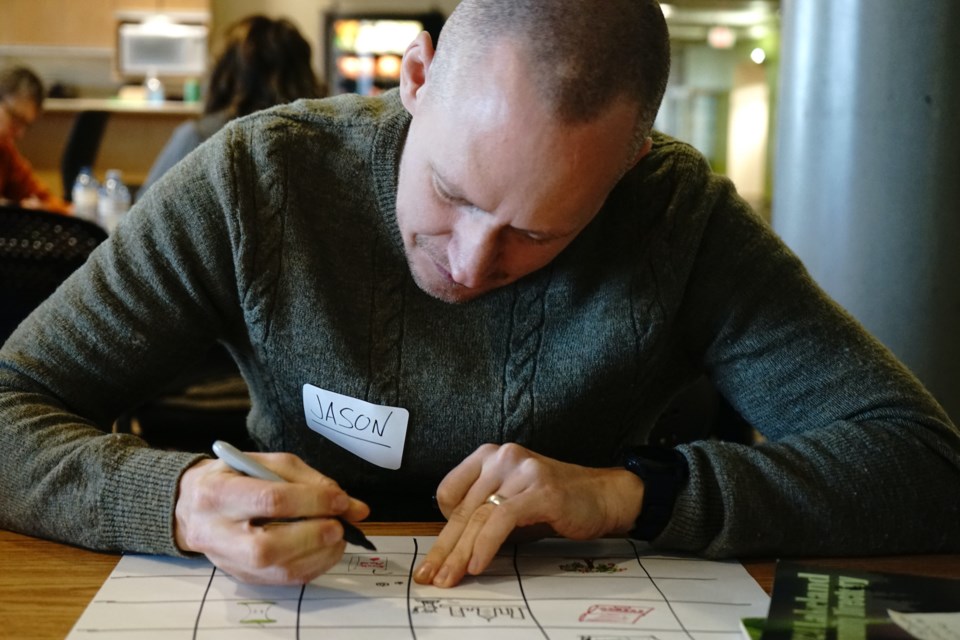ATHABASCA — More than 20 movers and shakers in Athabasca once again convened in Athabasca University’s Academic Research Centre for the first in-person session of the Design Lab since the New Year.
Social Impact Lab Alberta Project designer Kelsey Brown and Calgary United Way service designer Beth Ed greeted the session's participants with an ample supply of coffee the morning of Feb. 15 as the group prepared to start the task of what Brown and Ed call “ideation.”
“Dream as big as possible,” Brown told Athabasca designers. “Today is just a day to dream — it’s super exciting. It can get a little hectic because there’s a lot of information, but it’s also my favourite part of the process.”
During the Jan. 18 virtual session, participants voted to move forward with communication as the lab’s main focus. Although it was not included in the initial three topics the program would be solving for, Brown said gaps in communication arose as a theme throughout the process, and designers voted largely in favour of switching gears.
Community feedback
After January’s vote, lab members were tasked with further community research. Participants conducted more interviews with other locals with the goal of identifying where information is getting lost.
In groups, designers shared what they heard from the wider community, which included sentiment that newcomers need an ‘in’ to communication circles and networks, gaps in technological literacy and access, and the need for centralized hubs of information rather than a large number of singular sources like social media pages.
Great West Media (GWM) Vice-President and Town and Country This Week publisher Tim Shoults was present for the session to share information on GWM’s community directory publications and get acquainted with community perspectives on communication.
The intersection of communication and belonging emerged in group discussion, prompting consideration of how the two topics both intertwine and diverge in the context of community communication.
Brown said belonging had come up in initial discussions with the community in April 2023 as a possible umbrella topic alongside social supports.
“Belonging seems to be of value in the community of Athabasca,” said Brown. “My hope is that if we can significantly increase communication in Athabasca, we can contribute to a sense of belonging in the community … if we set out to only solve for belonging, then we’re missing some of the details that need to get us there.”
“It’s almost like an underlying theme,” said one participant. “If we put this out to the community, it's almost including our why and where we’re going with that.”
Group-generated ideation
Designers were also given research homework prior to the February session. Lab members looked into solutions to communication gaps implemented around the province, country, and across the globe.
Solutions identified ranged from a coalition of rural Albertan communities, educators, and non-profits proposing technical solutions and policy recommendations to increase connectedness for all Albertans, to the cultural habits in Indonesia that foster organic togetherness, and even those as seemingly simple as a shared community calendar like that used by the Town of Vegreville.
Using the SCAMPER method — which stands for substitute, combine, adapt, modify, put to another use, eliminate, and reverse — groups again congregated around their favourite solutions to analyze how each could be adapted to Athabasca.
Ideation around potential solutions to the communication gaps in Athabasca included a "community gallery,” complete with an in-house liaison, message boards, and local artisan displays.
Other ideas included hot dog roast community dinners hosted around the new riverfront fireplaces, inspiring greater connection amongst community members, and even a new iteration of the welcome wagon, complete with baked goods, resources, and information for newcomers to choose from.
The next session of the Athabasca Design Lab is scheduled for March 21, and will involve further breakdowns of the ideas curated in February to further develop potential solutions and address questions of ‘how.’
As the group moves past the halfway point of their design journey, hopes of reaching a workable solution for the community remain high and were summed up succinctly by one designer: “Together, we can do it.”


